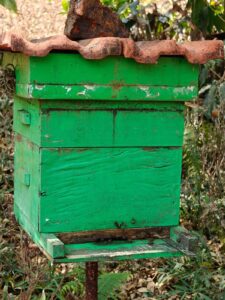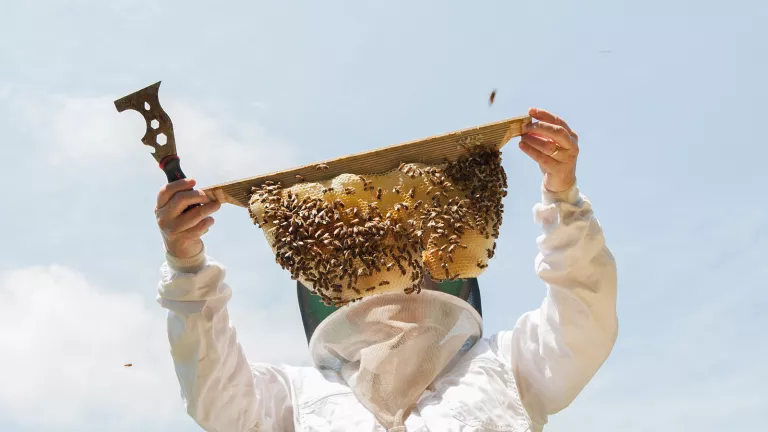We have had an outstanding response to our articles on Coffee – Pricing, Inventory Management, Blossoms and there will be more in this series.
We are happy to share a very important article on What Happens if Bees Go Extinct – an article that assesses our chances of survival without the prodigious pollinator.
In the context of Kodagu, while the coffee plant is self pollinating, it still needs cross-pollination from bees to develop healthy good quality yields. There are many reasons for the decline in bee population and other associated bad practices:
1. Cutting of trees and non-replacement of native species. Tata Coffee and BBTC started the trend decades ago and the local planters were quick to follow the trend of cutting precious trees for funding extravagant social spending and boosting corporate income. The dreaded Silver Oak became the norm for commercial exploitation with virtually no benefit for the soil and environment.
 2. Apiary or the old custom where all our grandmothers kept bee boxes at their homes was precisely for this reason. It would be futile to explain why?!
2. Apiary or the old custom where all our grandmothers kept bee boxes at their homes was precisely for this reason. It would be futile to explain why?!
3. Forest tree cover has depleted drastically – where is the chance for bees to survive – especially the wild rock bees.
4. Also for those in the know, a foreign species of bees was introduced in the 1980/90s which virtually destroyed our local bee population.
Beekeeping and Beekeepers is a very good professional opportunity. The Forestry College in Ponnampet is a good resource.
5. Rampant sprinkler irrigation and non-cultivation of paddy are ruining the water resources. Also irresponsible day-tripper tourists who add nothing to the local economy and destroy the environment with garbage litter and more. This should be curbed drastically.
The Forest Department, District Administration, Coffee Board and their Research Station in Chettalli, Codagu Planters Association, The Coorg Progressive Bee-Keeper’s Co-operative Society and leading planters should work together to remedy the situation. – CLN News Desk
A World Without Bees? Here’s What Happens If Bees Go Extinct
Assessing our chances of survival without the prodigious pollinator.
By: Brian Palmer, contributor to NRDC.org

There was more bad news on the honeybee front last week. A U.S. Department of Agriculture report found that honeybee losses in managed colonies—the kind that beekeepers rent out to farmers—hit 42 percent this year.
That number grabbed most of the headlines, but there was more troublesome data below the fold. The magic number in beekeeping is 18.7 percent. Population losses below that level are sustainable; lose any more, though, and the colony is heading toward zero. A startling two-thirds of beekeepers in the USDA survey reported losses above the threshold, suggesting that the pollination industry is in trouble.
For the first time, the USDA reported more losses in summer than winter. Experts can’t explain the reversal—especially since the colony collapse disorder epidemic that peaked several years ago seems to have abated. The summer losses may have a single, unknown cause, or a group of known and intensifying causes, such as pesticides or mites.
Today the White House followed the USDA’s report with its long-awaited plan to help maintain and grow the pollinator population, including building pollinator gardens near federal buildings and restoring government-owned lands in ways that support bees. It’s a good first step.
Albert Einstein is sometimes quoted as saying, “If the bee disappears from the surface of the earth, man would have no more than four years to live.” It’s highly unlikely that Einstein said that. For one thing, there’s no evidence of him saying it. For another, the statement is hyperbolic and wrong (and Einstein was rarely wrong). But there is a kernel of truth in the famous misquote.
Bees and Agriculture
Bees and humans have been through a lot together. People began keeping bees as early as 20,000 BCE, according to the late and eminent melittologist Eva Crane. (Yes, someone who studies bees is a melittologist.) To put that length of time into perspective, the average global temperature 22,000 years ago was more than 35 degrees Fahrenheit cooler than today, and ice sheets covered large parts of North America. Beekeeping probably predates the dawn of agriculture, which occurred about 12,000 years ago, and likely made farming possible.
How important are bees to farming today? If you ask 10 reporters that question, you’ll get 11 answers. Some stories say that bees pollinate more than two-thirds of our most important crops, while others say it’s closer to one-third. A spread of that size indicates a lack of authoritative scholarship on the subject. My review of the literature suggests the same.
The most thorough and informative study came back in 2007, when an international team of agricultural scholars reviewed the importance of animal pollinators, including bees, to farming. Their results could encourage both the alarmists and the minimizers in the world of bee observation. The group found that 87 crops worldwide employ animal pollinators, compared to only 28 that can survive without such assistance. Since honeybees are by consensus the most important animal pollinators, those are scary numbers.
Look at the data differently, though, and it’s clear why the misattributed Einstein quote is a bit of an exaggeration. Approximately 60 percent of the total volume of food grown worldwide does not require animal pollination. Many staple foods, such as wheat, rice, and corn, are among those 28 crops that require no help from bees. They either self-pollinate or get help from the wind. Those foods make up a tremendous proportion of human calorie intake worldwide.
Even among the 87 crops that use animal pollinators, there are varying degrees of how much the plants need them. Only 13 absolutely require animal pollination, while 30 more are “highly dependent” on it. Production of the remaining crops would likely continue without bees with only slightly lower yields.
OK, So Can We Live Without Bees?
The truth is, if honeybees did disappear for good, humans would probably not go extinct (at least not solely for that reason). But our diets would still suffer tremendously. The variety of foods available would diminish, and the cost of certain products would surge. The California Almond Board, for example, has been campaigning to save bees for years. Without bees and their ilk, the group says, almonds “simply wouldn’t exist.” We’d still have coffee without bees, but it would become expensive and rare. The coffee flower is only open for pollination for three or four days. If no insect happens by in that short window, the plant won’t be pollinated.
There are plenty of other examples: apples, avocados, onions, and several types of berries rely heavily on bees for pollination. The disappearance of honeybees, or even a substantial drop in their population, would make those foods scarce. Humanity would survive—but our dinners would get a lot less interesting.
This story was originally published by NRDC.org



How Emergency Fake Flowers Help Save Bees
Fearing for a declining bee population and collapsing insect colonies, Matilde Boelhouwer of the Netherlands put her design degree to creative use. The Dutch artist designed 3D printed, eco-friendly artificial flowers to help feed bees, butterflies and other insects facing a shrinking supply of food in urban environments.
Excellent article that CoffeeLand News shared regarding a very very important message regarding Honey bees.
We should not allow honey bees to go extinct. Our collective responsibility is to rear them in large scale in the coffee Estates in Kodagu Dist.
Every estate should be encouraged to introduce honey bees and there could be the beginnings of a coordinated business approach. Quite worryingly we are not finding bees in the estate at the time when blossom opens. This trend has to be reversed. It is a known fact bees are required for pollination of Robusta. This is my considered view after 50+ years of coffee plantations experience.
This paper discusses the importance of pollination, particularly by bees, in coffee production. While coffee plants can self-pollinate, having pollinators like bees significantly improves the yield and quality of coffee beans.
The study focuses on understanding how different levels of pollination impact coffee production and what factors influence pollination efficiency in a given area.
The researchers conducted their study in a coffee-growing region, likely observing different coffee farms with varying levels of bee activity. They compared coffee plants that had access to natural pollinators with those that did not. Data was collected on the number of flowers, the percentage of flowers that developed into berries, and the final yield of coffee beans.
They also studied the types of bees present and how their activity affected pollination.
The study found that farms with a higher presence of bees had better coffee yields. More flowers turned into coffee berries when bees were actively pollinating them. The results also showed that certain factors, such as maintaining natural habitats and reducing pesticide use, contributed to better pollination.
This confirms that while coffee can self-pollinate, having a strong pollinator presence significantly improves productivity and quality.
PDF File – Status of pollinators and their efficiency in coffee fruit
Sharing an age old clay Thene (honey) Potti from my residence.
Some valuable insights on managing coffee blossoms for optimal berry production were shared by my network of friends and colleagues:
They emphasized the importance of preserving native shade trees and forest patches, as these areas provide essential habitats for pollinators like the giant Asian honeybee, which significantly boosts pollination efficiency.
Another key point was maintaining sustainable irrigation practices during the flowering period to ensure blossoms remain viable and attractive to pollinators, which helps synchronize flowering and enhances pollination.
They also stressed that avoiding pesticide use while the plants are in bloom is crucial to protecting pollinators and ensuring uninterrupted activity during critical pollination windows.
Supporting local beekeeping initiatives was another recommendation, as establishing apiaries near coffee plantations can create a steady pollinator population.
They mentioned that institutions like the Forestry College in Ponnampet could provide useful resources for beekeeping.
Additionally, planting a variety of flowering plants that bloom at different times can provide a continuous food source for pollinators, keeping their populations stable throughout the year.
Lastly, they highlighted the need for educating and working closely with local farmers and communities. Spreading awareness about the role of pollinators and adopting sustainable farming practices can lead to collective efforts that benefit both coffee production and the surrounding ecosystem.
Very informative article which makes one think. There are diametrically varying views on best practice and outcomes, that needs to be resolved.
This article has attracted a lot of discussion on “pollination” to easily warrant enthusiastic young minds to undertake a Doctoral Thesis.
The comments have ranged from absolute self-pollination by the coffee plant to sane common sense on the forces of Nature. CLN has requested Coffee Board for their views and a note on best practices for managing the coffee blossoms to get the optimal berries.
Really happy to read these articles on Coffee – I absolutely adore the coffee from Coorg, alongwith the people, the landscape and delicious cuisine. While I live in New York I make it a point to visit Greece every year and drive up from Athena to the Peloponnese mountains. Fine wines, delicious food are the norm and the most unique honey. All along the forest pathways you will find bee boxes placed in select spots where beekeepers have their unspoken spots. There is no theft ever and it is considered a serious crime if honey or the boxes are stolen.
Bees are absolutely critical for pollination in the Greek environment. Interestingly, like coffee, most bunching grapes are self-fruitful and do not require a pollinator. That said, they will often benefit from having a pollinator nearby. the unique flavour notes are picked up from the flowering trees and shrubs in the surrounding areas. That’s the same phenomena in Coffee too. And there lies a tale – there are many things in common when it comes to vineyards/wine making and coffee plantations and taste profiles of coffee….terroir, climate, harvesting, processing and last but not the least – the way it is served and consumed.
Reminiscing my times of active life as a Planter, I can recall that around the time of coffee blossoms swarms of Rock Bees used to magically appear every year from far away forests. The “hum” of the bees returning home to their hives in large Ficus trees was a phenomena to be experienced. Come the Monsoon they retreated to the rocky hills of the plains.
This is not an accident or a coincidence – it is Nature’s delicate and intricate way of providing a balance to manage the requirements of pollination.
While coffee plants are self-pollinating as their flowers are hermaphrodites, cross-pollination does exist, as coffee bushes do have a flower that produces nectar and pollen. Insects, gravity, and wind must certainly play a role in pollination. Also, for a Coffee plantation to be healthy, all the trees and supporting fauna needs to be healthy, where pollination has a significant role to play. Interestingly most trees tend to flower around this time, before monsoon sets in.
Quite illuminating👌
Regreening and planting native variety of trees is so critical for the way Mother Nature works – strong sense of interdependence. The quote is so apt – “If the bee disappears from the surface of the earth, man would have no more than four years to live.”
Coffee plants do not exist in isolation and we have seen worse with forests and plantations that embrace monoculture.
Read the article with great interest. Thought it appropriate to share something that I received a while ago:
DID YOU KNOW?
🐝There are live enzymes in honey.
🐝When in contact with a metal spoon, these enzymes die.
🐝The best way to eat honey is with wooden or plastic spoon.
🐝Honey contains a substance that helps your brain work better.
🐝Honey is one of the rare foods on earth that alone can sustain human life.
🐝One teaspoon of honey is enough to sustain human life for 24 hours.
🐝Propolis that bees produce, is one of the most powerful natural antibiotics
🐝Honey has no expiration date.
🐝The bodies of the great emperors of the world were buried in golden coffins and then covered with honey to prevent putrefaction.
🐝The term “honeymoon” comes from the fact that newlyweds consumed honey for fertility after the wedding.
🐝A bee lives less than 40 days, visits at least 1000 flowers and produces less than a teaspoon of honey in its lifetime.
🐝One of the first coins had a bee symbol on it.
Deep gratitude to the humble BEE!🐝
Very informative article.
To understand better about this subject,I would recommend to consult Mr Apparanda Suresh Chengappa, Honey valley, Kakkabbe, Coorg,who was then the largest individual producer of honey in South East Asia.
My analysis coffee flowers are useful for Honey bees but definitely they are not interdependent but it may help in increasing the yield though it’s not very sure as bees are very selective choosing certain coffee flowers . It could be facultative self pollinating plant.